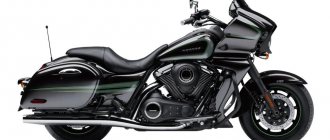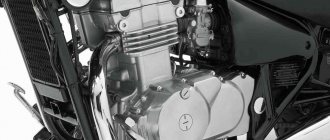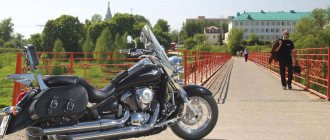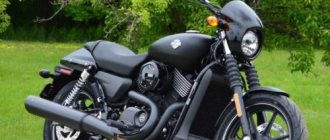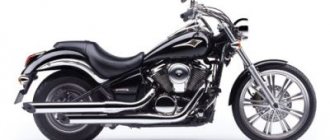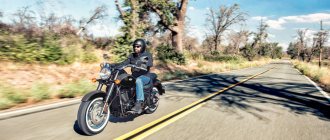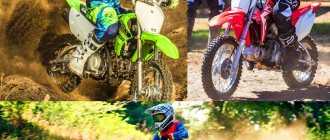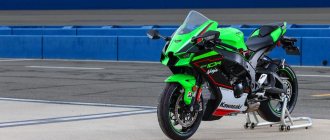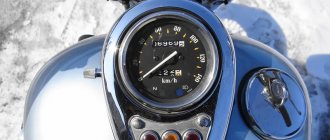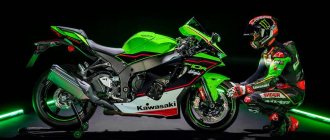Cruiser Kawasaki Vulcan 1700 Voyager 2019
The Kawasaki Vulcan 1700 is a whole line of cruisers, which includes, in particular, a bagger and a full dresser.
*The last term has not yet been established in the Russian language, so we will briefly explain its essence. Dresser in English is a wardrobe or chest of drawers with several drawers, and in the case of motorcycles, this apt term means a device with a standard set of wardrobe trunks, sometimes even non-removable. Unlike a dresser, a bagger is a device with standard side cases, devoid of a central one, and often has a more urban orientation than tourism-oriented dressers. It is characterized by more rapid contours, low comfort of the passenger seat or its complete absence, and the bagger can also be more “undressed”, deprived of part of the hood, if its “dressed” version - the dresser - has one.
Both cruisers are equipped with ABS, have a 1700 cc V-twin engine with liquid cooling and a six-speed transmission. Ready to zip around town or hit the highway, the 1700 Vulcans are quality, reliable motorcycles.
Appearance
Regardless of the modification, the Kawasaki VN 1700 Vulcan looks solid, just look at the photo once to be convinced of this. This is a huge motorcycle with a steel tubular frame, low seating position and a large tank.
Classic is the most traditional version of this bike; it is not equipped with a windshield, which fully corresponds to its name. By the way, it’s not really needed here, because the car is not suitable for high speeds.
The wheels here are alloy, which is within the class limits. Made in classic style. There are different colors, but the best models are black and chrome. The headlight is of impressive dimensions.
It’s immediately clear that, like many other cruisers, this option is suitable for riding as a two-person cruiser. However, in this regard, the Voyager, Classic Tourer and Classic LT modifications are safer, since they have rear insurance for the passenger.
Comfort
Firstly, it’s worth talking about the noise level. This one is small, thanks to the belt drive. This distinguishes the Kawasaki VN 1700 Vulcan from many other representatives of the brand.
As a result, when changing gears, there are no various clanging and other unpleasant sounds that certainly accompany chain drives and cardan shafts.
Secondly, the motorcycle does not fall over when cornering, even at low speeds, which makes it convenient for city yards. It is important to note the quality of the materials from which the seat is made.
However, there is also a drawback. The instrument panel is inconvenient to look at due to the fact that it is located low. However, this is also what makes for great design. This is not to say that this is a big minus.
From many first-person videos it is clear that if desired, the driver will not have any difficulty looking at the panel. It's just not as convenient as on many other models. But definitely nothing will interfere with the view.
As for the speedometer, everything is not clear. Miles are poorly distinguishable, but kilometers, on the contrary, are well distinguished. So comfort here depends directly on what country the owner of the motorcycle lives in. But, of course, it would be better if all the speedometer readings were clearly visible.
Dimensions and weight
The classic version reaches 2500 mm in length, 1025 mm in width and 1155 mm in height.
Other options are almost the same in length and width, but the difference in height is greater:
- Voyager – 1550 mm;
- Classic LT and Classic Tourer – 1465 mm;
- Vacuero – 1290 mm.
The curb weight of the models also varies:
- Classic – 345 kg;
- Classic LT – 362 kg;
- Classic Tourer and Vaquero – 378 and 379 kg;
- Voyager - 402 kg.
The wheelbase of all reaches 1665 mm. It cannot be said that the dimensions in this case greatly affect controllability and maneuverability, although there is still a correlation.
And for urban conditions, of course, the classic version will be more convenient, or the Classic LT, if you like the windshield and plan to ride with a passenger.
Engine
Kawasaki builds a line of big Vulcans to suit the tastes of the American consumer: it's a cruiser, it's a V-twin, and it's as many cubic inches as possible. The engine in this line is 1700 cubic centimeters or 103.7 cubic inches, and this is one of the largest V-twins in the world. And even despite the heavy weight of the devices, these are some of the most high-torque motorcycles with their 146 Nm of torque . The water-cooled engine has a 52-degree cylinder angle and is ideal for cruisers. The cylinders have a diameter of 102mm and a piston stroke of 104mm, giving it a slightly long-stroke character, while the 9.5:1 compression ratio allows it to run on relatively inexpensive grades of petrol. The engine breathes through two throttle bodies with a diameter of 42 mm. Power is transmitted from a six-speed high-ratio transmission to the rear wheel via a carbon fiber-reinforced belt.
So, this car is too heavy for drag racing, but it is great for touring, especially on the highway, where thanks to two high-speed top gears, the car rides well at low revs, while having a large reserve of torque for rapid overtaking.
Specifications
In terms of its filling, the Kawasaki VN 1700 Vulcan is measured. It is unlikely to surprise or upset anyone. Reliable and productive, it does not claim to be a leader in any category. Below is a description of the main parameters.
| Motor type | V-shaped, 4-stroke, 2-cylinder |
| Power | 73.4 hp |
| Torque | 136 Nm |
| Maximum speed | 183 km/h |
| Acceleration to 100 | 5.40 s |
| Fuel consumption per hundred | 6.72 l |
| Drive unit | belt |
| Transmission | six-speed |
| Frame | tubular steel |
| Rear suspension | 80 mm, pendulum, 2 shock absorbers |
| Front suspension | 43 mm, telescopic fork, 140 mm travel for Vaquero and Voyager - 45 mm |
| Rear brakes | 300 mm, 1 disc, two-piston caliper |
| Front brakes | 300 mm, 2 discs, two-piston calipers |
It is also possible to install ABS if desired. It definitely won’t be superfluous, taking into account the dimensions of the bike. Otherwise, nothing needs to be improved; the car is balanced and reliable. The machine rarely breaks down, you only need to change consumables.
Therefore, maintenance is inexpensive. So it is possible to say that the technical characteristics of the Kawasaki VN 1700 Vulcan are optimal.
Full cruise control
The devices have a convenient cruise control setting, performed on the right remote control, and this is not just a lock of the throttle, but full-fledged cruise control. The speed can be set in the range from 48 to 136 km/h, it can be changed on the go, and the device will maintain it even on ups and downs.
History of changes
Kawasaki VN 1700 Vulcan changed gradually:
- In 2009, production began and the motorcycle appeared on the market. All versions except Vaquero were produced.
- In 2011, the Vaquero modification appeared, and the Classic LT ceased to be sold.
- In 2015, the Classic was no longer offered.
- In 2022, production and sales in Europe ended, as did the sales of the Classic Tourer.
It is difficult to say how long Voyager and Vaqueero will be produced. The motorcycle is, of course, good, but sooner or later it will be replaced by new models.
Taking into account how much a new car costs and taking into account the advantages of the Classic, for many, purchasing the classic used version has become a priority. It is still not difficult to get spare parts for it.
Hello everyone :)
I have had a Vulcan Voyager for a long time, but I had nothing to write about it - I had never traveled far in it before. But a couple of days ago the need arose to travel on it from Sochi to Moscow (in one day). I’ll say right away that I didn’t prepare for the trip, I only took a raincoat from a friend and put on a sweatshirt under my motorcycle jacket and set off at 9 pm.
An hour later, the beautiful evening weather gave way to rain and 70% of the serpentine had to be driven in the rain. The rear wheel did not skid even once (thanks to the weak engine, I have never had such slow motorcycles before :). Then the rain continued, the road straightened out and I drove in complete darkness at about 100 km/h. I removed my limbs from the brakes, remembering that “the boat itself is stable and will not fall while the wheels are spinning”... hmm... maybe I should close my eyes, I thought then, I can’t see anything anyway :) But, lo and behold, this cargo ship actually galloped on squeezed-out asphalt hills, which I passed regularly, flew a couple of times over the corpses of animals the size of cats, and never once made me realize that all this time I was driving on water-filled asphalt.
In the Rostov and Voronezh regions, the rain stopped fighting the raincoat and was replaced by cold (+8C). Isn't it cold? but I went out at +23C and I was wearing clothes that were appropriate for the starting weather :) Here is the second advantage of such spendthrifts - my feet remained dry (well, almost). Of course, I shortened the windshield after the first trip in the rain, since the road stops appearing through the layer of dirt on it literally immediately. All the other wind protection saved me perfectly :) But one hope was not justified :( This moto has a rather large engine and looks more like a stove because it produces more heat than movement, so it seemed to me when in warm weather I had to crawl in traffic jams. And I I hoped that it would be the engine that would reliably warm me up on the road, but no, no, no. In cold weather it was a little warm - someone would have warmed it up :) This disappointment almost forced me to look for a motel. But there were only 500 km left to Moscow. As soon as the Moscow region began, as you guessed, it started to rain again :( But I was already mentally prepared for this.
How much does he rush, how much does he eat? If you drive 110, then the tank is enough for 300 km, but no one rides 110 motorcycles;-) Therefore, the tank was enough for me for 150 km, yes, yes. at 150 km. And this is not at all at maximum speed. By the way, Voyager has only 186 km/h. In a passenger car, I spend 5,000 rubles on gasoline on the Moscow-Adler route. on Voyager it turned out to be a little more than 7000 rubles.
The average speed due to frequent refueling is exactly the same as by car.
And only this time I appreciated the cruise control! hurray, it allows you to drive without holding the steering wheel. This is impressive and, most importantly, allows you to stretch stiff members without stopping. I really missed this on my previous motorcycles.
Well, at the end there’s a bonus - a traffic jam on the Moscow Ring Road :) another hour and I’m in the garage :) Whiskey, pillow, no dreams. Good luck to all!
What do the owners say?
Judging by the reviews, at first it is uncomfortable to hold your feet on the model, but after the first ten kilometers a person gets used to it.
It is noticed that this bike, close to road motorcycles, gives a feeling of power at first, but after shifting from second gear, a sharp decline in this power is felt, and the machine begins to feel smooth.
The owners also note that the model does not fall over at low speeds, which makes it convenient for the city, where traffic is usually high. The motorcycle is also suitable for small people.
If the latter is 150cm, this Kawasaki motorcycle will do just fine. Many owners note that in order to like it, one should ideally like the class of such leisurely cars. Otherwise, you should choose a sportbike or a motocross motorcycle, or something else.
In conclusion, it is worth noting that the Kawasaki VN 1700 Vulcan is a motorcycle that is clearly in its category, the category of leisurely bikes for a leisurely and measured ride. It's not suitable for anything else, but that's not a drawback. An option for those who love leisurely travel and sedate motorcycles.
Main modifications of the Kawasaki VN 1700 Vulcan:
Kawasaki VN 1700 Vulcan Classic is a regular classic version.
Kawasaki VN 1700 Vulcan Classic LT (Light Tourer) - regular version + windshield + leather side bags + passenger seat backrest.
Kawasaki VN 1700 Vulcan Nomad (Classic Tourer) - version with built-in side plastic panniers, high glass, backrest and cruise control.
Kawasaki VN 1700 Vulcan Voyager is a touring version with a large front fairing (with tall glass), integrated rear and side saddlebags and a leather passenger backrest (similar to the Harley-Davidson Electra Glide Classic).
Kawasaki VN 1700 Vulcan Vaquero - This version is similar to the Voyager, but has a short windshield and comes without a passenger backrest and rear case (similar to the Harley-Davidson Electra Glide Standard).
2010 was the final year of production for the Classic LT version, 2014 for the Classic, and 2016 for the Classic Tourer (Nomad).
Currently, only the Voyager and Vaquero versions offered in the North American market are available.
Kawasaki Vulcan 1700: electronic options
Electronic cruise control K-ACT II (Kawasaki Advanced Coactive-Braking Technology) ABS
